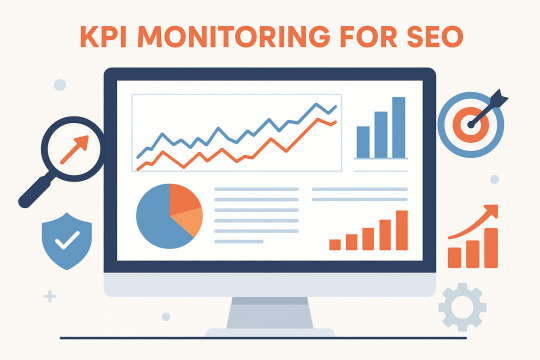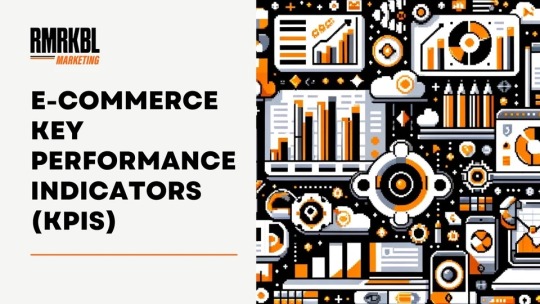#KPI monitoring for SEO
Explore tagged Tumblr posts
Text
Why KPI Monitoring for SEO is Essential for Digital Success

In the ever-evolving world of digital marketing, KPI monitoring for SEO plays a crucial role in ensuring your website stays on track and continues to grow. If you’ve ever wondered why your rankings fluctuate or why some strategies yield better results than others, the answer often lies in how well you monitor and interpret your SEO KPIs.
What are SEO KPIs?
Before diving deeper, let’s clarify what KPIs are. KPI stands for Key Performance Indicator- a measurable value that shows how effectively a campaign is achieving its objectives. In SEO, KPIs help you track performance indicators like organic traffic, bounce rates, keyword rankings, conversion rates, and more.
When you engage in KPI monitoring for SEO, you’re not just looking at random numbers. You’re analyzing data that tells you how well your content, keywords, and strategies are performing in real time. This insight allows you to make informed decisions rather than relying on guesswork.
Why Is KPI Monitoring for SEO So Important?
Let’s face it-SEO is a long-term game. Unlike paid ads, results take time to appear, and trends can shift quickly. That’s where KPI monitoring for SEO becomes essential. By consistently keeping an eye on key metrics, you can:
Spot opportunities: If a certain blog post or keyword is gaining traction, you can capitalize on it by creating more related content.
Fix problems early: A sudden drop in traffic could signal technical issues, algorithm updates, or content problems. Monitoring KPIs lets you catch and fix these quickly.
Measure ROI: It’s important to know whether your SEO efforts are actually driving revenue. KPI tracking gives you a clearer picture of what’s working.
Improve user experience: KPIs like bounce rate and average session duration tell you whether your content is engaging or if users are bouncing away too quickly.
Essential KPIs You Should Monitor
While there are dozens of metrics out there, here are some key ones you should definitely include in your KPI monitoring for SEO strategy:
Organic Traffic: This shows how many people are visiting your site via unpaid search results. An increase means your content is being discovered more often.
Keyword Rankings: Tracking how your targeted keywords perform over time helps you understand what’s resonating with your audience.
Click-Through Rate (CTR): A low CTR could mean your meta titles or descriptions need improvement.
Bounce Rate: If users leave your page quickly, it might mean the content isn’t relevant or engaging enough.
Conversion Rate: This tracks whether users are taking the desired action—buying, signing up, or contacting you.
Tools That Make KPI Monitoring Easier
You don’t have to track everything manually. Tools like Google Analytics, Google Search Console, SEMrush, and Ahrefs can automate a lot of the work. They provide dashboards, graphs, and reports that make KPI monitoring for SEO more manageable and actionable.
If you’re running an agency or managing multiple websites, using a central dashboard that aggregates SEO KPIs across projects can save a lot of time and effort.
Final Thoughts
SEO isn’t a one-time task - it’s an ongoing process of optimization, analysis, and adaptation. That’s why KPI monitoring for SEO is not just a good practice - it’s a necessity. By staying on top of your data, you can continuously refine your strategy, outperform competitors, and deliver real value to your audience.
Whether you’re an entrepreneur managing your own website or a marketer overseeing several projects, implementing a structured approach to SEO KPI tracking can make the difference between digital success and wasted effort.
0 notes
Text
New Business Marketing Tips and Tricks for Success
Starting a new business can be an exhilarating adventure, but it also comes with its fair share of challenges, especially in the competitive landscape of today's marketplace. To stand out and thrive, effective marketing is crucial. Here are four essential marketing tips and tricks to help your new business succeed:
Define Your Target Audience and Create Customer Personas:
One of the first steps in crafting a successful marketing strategy for your new business is to identify and understand your target audience. Who are your ideal customers, and what are their needs, preferences, and pain points? Creating customer personas can help you visualize and humanize your audience, making it easier to tailor your marketing efforts effectively.

Start by conducting market research to gather data about your potential customers. Analyze demographics, psychographics, and behavior patterns to create detailed customer personas. These personas should include information like age, gender, income, interests, and pain points.
Once you have a clear understanding of your target audience, customize your marketing messages and strategies to resonate with them. Craft compelling content, advertisements, and promotions that address their specific needs and desires. By speaking directly to your ideal customers, you'll increase the chances of building meaningful connections and driving conversions.
Leverage the Power of Digital Marketing:
In the digital age, online presence and digital marketing are indispensable for any new business. Here are some essential digital marketing strategies to consider:
a. Build a User-Friendly Website: Your website is often the first point of contact for potential customers. Ensure that it is well-designed, easy to navigate, and mobile-responsive. Optimize it for search engines (SEO) to improve your visibility in search results.
b. Content Marketing: Create valuable and relevant content that educates, entertains, or solves problems for your target audience. Blog posts, videos, infographics, and social media updates can all be part of your content marketing strategy.

c. Social Media Marketing: Identify the social media platforms where your audience is most active and engage with them there. Develop a content calendar and use a mix of organic and paid content to reach a wider audience.
d. Email Marketing: Build and nurture an email list to stay in touch with your customers. Send personalized and relevant content, offers, and updates to keep them engaged and informed.
e. Pay-Per-Click Advertising (PPC): Consider running targeted PPC campaigns on platforms like Google Ads and Facebook Ads to reach potential customers actively searching for your products or services.
Emphasize Customer Relationships and Engagement:
In a competitive market, building and maintaining strong customer relationships is vital. Consider these strategies to enhance customer engagement:
a. Provide Exceptional Customer Service: Respond promptly to inquiries and address customer concerns with care. Happy customers are more likely to become loyal advocates for your brand.
b. Personalization: Use customer data and segmentation to personalize your marketing messages and offers. People appreciate tailored experiences that cater to their unique preferences.

c. Encourage User-Generated Content: Encourage customers to share their experiences with your products or services on social media or review platforms. User-generated content can build trust and credibility.
d. Loyalty Programs: Reward repeat customers with loyalty programs, discounts, or exclusive access to new products or services. Loyalty programs can foster long-term relationships and increase customer retention.
Monitor, Analyze, and Adapt:
Marketing is not a one-size-fits-all endeavor. To continually improve your strategies, track key performance indicators (KPIs) and adapt based on the data:
a. Use Analytics Tools: Employ tools like Google Analytics, social media insights, and email marketing metrics to monitor the performance of your marketing efforts.
b. A/B Testing: Experiment with different marketing approaches and compare their results through A/B testing. This allows you to refine your strategies over time.

c. Stay Informed: Keep up with industry trends, competitors, and evolving customer preferences. Stay open to adjusting your marketing plan as needed.
In conclusion, successful marketing for a new business involves understanding your audience, utilizing digital strategies, fostering customer relationships, and staying adaptable. By implementing these tips and tricks, your new business can navigate the competitive landscape and carve out its own path to success.
#seo#online marketing#digitalmarketing#marketing agency#learn digital marketing#digital marketing service#seo marketing#digital marketing course#digital marketing#seo expert#business success#business marketing#marketing tips
25 notes
·
View notes
Text

1. Understand Your Audience
Create detailed buyer personas to identify your audience's needs and preferences.
Use tools like Google Analytics, social media insights, and customer surveys to gather data.
2. Optimize Your Website
Ensure your site is mobile-friendly and fast-loading.
Use SEO best practices: include keywords, meta tags, and quality backlinks.
3. Leverage Social Media
Post consistently with engaging and visually appealing content.
Utilize platform-specific features like Instagram Reels, LinkedIn articles, or TikTok trends.
Interact with your audience through comments and direct messages.
4. Content Marketing
Share educational and valuable content like blogs, videos, or infographics.
Use storytelling to make your brand relatable.
5. Email Marketing
Personalize your emails with recipient names and tailored content.
Offer exclusive deals and actionable call-to-actions (CTAs).
6. Use Paid Ads Strategically
Experiment with Google Ads or social media ads for targeted reach.
A/B test ad copy and visuals to find what works best.
7. Video Marketing
Use videos to explain products, share testimonials, or showcase behind-the-scenes content.
Optimize videos for SEO by using relevant titles and descriptions.
8. Track and Analyze Results
Monitor key performance indicators (KPIs) like click-through rates (CTR) and conversion rates.
Use analytics tools to refine strategies.
#AIinMarketing#HyperPersonalization#UserGeneratedContent#InteractiveMarketing#ARVRMarketing#SocialMediaShorts#ContentRepurposing#ProgrammaticSEO#B2BInfluencers#NativeAdvertising#digital marketing#seo agency#off page seo#seo#seo marketing#social media#seo services#digital marketing services#social media marketing#content marketing#search engine optimization
2 notes
·
View notes
Text
Maximizing Ecommerce Success: A Comprehensive Guide to Key Performance Indicators (KPIs)

Introduction
In the dynamic landscape of online retail, performance metrics are the compass guiding businesses toward success. Key Performance Indicators (KPIs) serve as crucial milestones, directing ecommerce entrepreneurs to navigate the complex realm of sales, marketing, and customer service. In this comprehensive guide, we at RMRKBL Marketing delve into the intricate world of KPIs, offering profound insights to empower your business decisions and drive unparalleled growth.
Unveiling the Essence of Performance Indicators
A performance indicator, a beacon in the data-driven journey, is a quantifiable measurement aligning with specific goals. Picture an online retailer aspiring to boost site traffic by 50% in the next year – a noble ambition. Key indicators could include daily unique visitors, traffic sources (paid advertising, SEO, brand advertising), or the holy grail of customer lifetime value.
Decoding Key Performance Indicators
Amidst a plethora of potential metrics, the crux lies in identifying key performance indicators (KPIs) – impactful data points succinctly reflecting progress toward defined goals. In this pursuit, Shopify's robust reporting and analytics emerge as invaluable tools, boasting over 60 pre-built dashboards to illuminate trends and catalyze informed decision-making.
The Significance of KPIs
Why are KPIs as vital as strategy and goal setting? They transcend mere statistics, offering actionable insights that propel strategic decision-making. Without KPIs, businesses risk navigating uncharted waters, relying on intuition rather than data-driven precision. Harnessing KPIs fosters a deeper understanding of your business and clientele, fostering informed strategies for online sales growth.
Classifying Key Performance Indicators
KPIs, versatile in nature, span qualitative, quantitative, predictive, and historical dimensions, permeating various business operations. In the ecommerce domain, KPIs elegantly align with five core categories: Sales, Marketing, Customer Service, Manufacturing, and Project Management.
Sales: A Symphony of Success
In the realm of sales, mastering KPIs is akin to orchestrating a symphony of success. Ecommerce retailers can fine-tune their performance through vigilant tracking of crucial metrics such as total sales, average order
size, gross profit, average margin, and more. Each metric unveils a facet of your business, from understanding customer behavior through conversion rates and shopping cart abandonment rates to strategic insights on product affinity and competitive pricing.
Unlocking Sales KPIs
1. Total Sales
Ecommerce success hinges on understanding sales patterns. Monitor sales on an hourly, daily, weekly, monthly, quarterly, and yearly basis to discern trends and capitalize on peak periods.
2. Average Order Size
Delve into customer spending habits with the average order size, a pivotal KPI reflecting the typical expenditure per order. This insight informs pricing strategies and product bundling opportunities.
3. Gross Profit
Measure business efficiency by calculating gross profit – the difference between total sales and the cost of goods sold. A nuanced understanding ensures profitability and strategic decision-making.
4. Conversion Rate
Efficiency in converting visitors to customers is paramount. The conversion rate, expressed as a percentage, illuminates the success of your ecommerce site in turning visitors into buyers.
5. Customer Lifetime Value (CLV)
The heartbeat of sustainable growth lies in the customer lifetime value. Nurture long-term relationships by understanding how much a customer contributes over their engagement with your brand.
6. Revenue per Visitor (RPV)
Evaluate the effectiveness of your site in converting visitors into revenue. Low RPV prompts a deep dive into analytics, optimizing the user experience to drive more online sales.
7. Customer Acquisition Cost (CAC)
Strategically invest in customer acquisition by deciphering the cost of acquiring new customers. Analyze marketing spend breakdown to ensure efficient customer acquisition.
8. Inventory Levels
Maintain optimal stock levels by closely monitoring inventory metrics. Insights into stock turnover, product velocity, and sitting stock guide inventory management strategies.
9. Competitive Pricing
Benchmark against competitors by scrutinizing pricing strategies. An agile approach to pricing ensures your business remains competitive and attuned to market dynamics.
10. Product Affinity
Uncover cross-promotion opportunities through product affinity analysis. Identify products frequently purchased together, fueling targeted marketing strategies.
11. Product Relationship
Strategically plan cross-selling tactics by understanding which products are viewed consecutively. Leverage this KPI to enhance product recommendations and elevate user experience.
12. Churn Rate
Customer retention is paramount. The churn rate reveals how swiftly customers are departing. Swift action can mitigate losses and foster sustained loyalty.
13. Cost per Click (CPC)
For paid advertising success, track the cost incurred for each click. Optimize ad campaigns by aligning CPC with conversion rates, ensuring a balanced marketing budget.
Marketing Mastery: Unleashing Potency Through KPIs
Marketing KPIs wield immense power in sculpting the success story of your ecommerce venture. From driving website traffic to deciphering customer behavior, these metrics guide strategic marketing endeavors.
Navigating Marketing KPIs
1. Website Traffic
Website traffic serves as the heartbeat of ecommerce success. Monitor the total number of visits to your site, interpreting trends and refining marketing strategies accordingly.
2. New Visitors vs. Returning Visitors
Distinguish between first-time visitors and returning patrons. This insight aids in assessing the efficacy of digital marketing campaigns and tailoring strategies for diverse audiences.
3. Time on Site
Evaluate user engagement by analyzing the time visitors spend on your website. A deeper engagement with blog content and landing pages signals brand affinity.
4. Bounce Rate
High bounce rates demand attention. Investigate the reasons behind visitors exiting after viewing a single page, optimizing user experience and content relevance.
5. Page Views per Visit
Navigate user journeys by understanding the average number of pages viewed during each visit. Balance engagement with ease of navigation to enhance the user experience.
6. Average Session Duration
Dive into user behavior with the average session duration. Longer durations indicate profound interactions with your site, particularly with blog content and landing pages.
7. Traffic Source
Decipher the origins of website traffic through the traffic source KPI. Channel-specific insights guide focused marketing efforts, whether from organic search, paid ads, or social media.
8. Mobile Site Traffic
Optimize for mobile success by monitoring the influx of users accessing your store via mobile devices. A mobile-friendly site ensures a seamless experience for a diverse audience.
9. Newsletter Subscribers
Harness the potential of email marketing by tracking newsletter subscribers. Analyze demographics to tailor content and maximize reach, ensuring alignment with target audiences.
10. Email Open Rate
Elevate email marketing effectiveness by scrutinizing the percentage of subscribers opening your emails. Test subject lines and maintain list hygiene for optimal engagement.
11. Email Click-Through Rate (CTR)
Drive traffic to your site with a high email click-through rate. This KPI measures the percentage of subscribers clicking on links, a pivotal factor in conversion success.
12. Social Followers and Fans
Measure brand loyalty and awareness through social media metrics. The number of followers and fans on platforms like Facebook, Instagram, and Twitter signifies audience engagement.
13. Return on Ad Spend (ROAS)
Evaluate ad campaign efficacy by gauging the revenue earned for every dollar spent on advertising. ROAS serves as a compass, steering advertising strategies toward profitability.
14. Cost per Click (CPC)
Unveil the cost incurred for each click on paid ads. Efficiently manage marketing budgets by aligning CPC with conversion rates, ensuring optimal returns on investment.
15. Social Media Engagement
Quantify brand engagement with social media followers through the social media engagement KPI. Active interaction signals a vibrant community and potent brand-consumer connections.
16. Clicks
Track the total number of clicks across various platforms – website, social media, email, and ads. A holistic perspective aids in refining content and optimizing engagement strategies.
17. Average Click-Through Rate (CTR)
Measure user engagement with the average click-through rate, revealing the percentage of users clicking on links. Optimize content placement and messaging for heightened effectiveness.
18. Average Position
Ascend the search engine ranks with insights from the average position KPI. Understand your site's SEO and paid search performance, striving for the coveted top position.
19. Pay-Per-Click (PPC) Traffic Volume
Evaluate the success of PPC campaigns by tracking traffic volume. Strategic adjustments based on PPC insights ensure targeted traffic influx to your site.
20. Blog Traffic
Uncover the impact of blog content by isolating blog traffic metrics. Compare blog traffic against overall site traffic for a nuanced understanding of content effectiveness.
21. Number and Quality of Product Reviews
Harness the power of social proof with product reviews. Track quantity and content to leverage customer feedback for SEO, brand credibility, and business refinement.
22. Banner or Display Advertising CTRs
Optimize banner and display ad performance by scrutinizing click-through rates. Insights into copy, imagery, and offer effectiveness guide strategic adjustments for enhanced engagement.
23. Affiliate Performance Rates
Leverage affiliate marketing with insights into performance rates. Identify successful channels, refining strategies to maximize the impact of affiliate partnerships.
Elevating Customer Service through KPI Excellence
Customer service KPIs stand as sentinels, guarding the gateway to customer satisfaction. Scrutinize these metrics to ensure your support teams exceed expectations and cultivate lasting customer relationships.
Pioneering Customer Service KPIs
1. Customer Satisfaction Score (CSAT)
Quantify customer satisfaction through the CSAT metric. Harness customer feedback to refine service strategies and foster a positive brand perception.
2. Net Promoter Score (NPS)
Measure customer loyalty with the Net Promoter Score. Identify brand advocates and detractors, directing efforts toward building a robust community of brand enthusiasts.
3. First Response Time
Efficient customer service hinges on swift responses. Monitor the time taken for the first response to gauge support team efficacy and ensure timely issue resolution.
4. Ticket Resolution Time
Expedite issue resolution by scrutinizing ticket resolution times. Streamline support processes based on these insights to enhance customer satisfaction.
5. Customer Retention Rate
A flourishing business thrives on customer retention. The retention rate KPI illuminates the success of your efforts in cultivating lasting relationships with clients.
6. Customer Complaint Resolution
Transform challenges into opportunities by mastering customer complaint resolution. Evaluate resolution times and customer feedback to fortify your support ecosystem.
7. Service Level Agreement (SLA) Adherence
Set and surpass customer expectations with SLA adherence. Track the percentage of support requests meeting agreed-upon response and resolution times.
8. Customer Effort Score (CES)
Simplify customer interactions with the Customer Effort Score. Minimize friction in customer journeys, fostering seamless and enjoyable experiences.
9. Contact Volume
Analyze contact volume to understand support team workload. Proactive adjustments to staffing and resources ensure consistent service excellence.
10. Customer Service Channel Performance
Decipher the effectiveness of various customer service channels – live chat, email, phone. Optimize resource allocation based on channel performance to maximize customer satisfaction.
11. Agent Performance
Empower support teams through insights into agent performance. Identify top performers and areas for improvement, ensuring a high standard of service across the board.
Conclusion: Mastering the Art of KPIs for Ecommerce Triumph
In the intricate tapestry of ecommerce success, KPIs serve as the warp and weft, weaving a narrative of progress and prosperity. Unleash the potential of your online venture by embracing the nuanced insights offered by sales, marketing, and customer service KPIs. Propel your business forward, navigate challenges, and sculpt a legacy of unparalleled success in the competitive realm of online retail.
FAQs
Why are KPIs crucial for ecommerce success?
KPIs, or Key Performance Indicators, provide quantifiable insights into the performance of various aspects of your ecommerce business. They guide strategic decision-making, enhance customer experiences, and drive overall success by aligning actions with specific goals.
How can I use KPIs to improve my online sales?
Analyzing sales KPIs such as total sales, average order size, conversion rate, and customer lifetime value empowers you to optimize pricing strategies, understand customer behavior, and implement targeted marketing efforts for increased online sales.
What role do marketing KPIs play in ecommerce?
Marketing KPIs, including website traffic, engagement metrics, and return on ad spend, offer actionable insights into the effectiveness of your marketing efforts. These metrics help refine strategies, boost brand awareness, and drive targeted traffic to your ecommerce site.
How do customer service KPIs contribute to business growth?
Customer service KPIs, such as customer satisfaction scores, first response time, and ticket resolution time, play a pivotal role in fostering positive customer relationships. Meeting and exceeding customer expectations leads to increased loyalty, positive word-of-mouth, and sustained business growth.
Can KPIs really help in inventory management?
Absolutely. Sales KPIs related to inventory levels, product affinity, and competitive pricing provide crucial insights into stock turnover, product popularity, and market competitiveness. Effectively managing inventory based on these KPIs ensures optimal stock levels and minimizes wastage.
Are there specific KPIs for evaluating the success of PPC campaigns?
Yes, monitoring KPIs such as pay-per-click (PPC) traffic volume, cost per click (CPC), and return on ad spend (ROAS) provides a comprehensive view of your PPC campaign performance. These metrics help optimize ad budgets, refine targeting, and maximize the impact of your advertising efforts.
Can KPIs help me understand the effectiveness of my social media marketing?
Certainly. Social media KPIs like social followers, engagement metrics, and click-through rates provide insights into the impact of your social media efforts. Understanding these metrics enables you to refine content strategies, build brand loyalty, and expand your social media presence.
How often should I review and update my KPIs?
Regular reviews are crucial to adapt to changing market dynamics. Consider monthly reviews for short-term KPIs and quarterly or annually for long-term goals. Adjust KPIs based on business priorities, industry trends, and the evolving needs of your ecommerce venture.
#digital marketing#e-commerce#localbusiness#marketing#seo#seo agency#seo company#local#seo expert#kpi#kpi metrics
9 notes
·
View notes
Text
The Best Digital Marketing Course in Agra

Pingmedia stands out as one of the leading providers of Digital Marketing Course in Agra. Renowned for its comprehensive and practical approach, Ping media Digital Marketing Course is designed to equip students, professionals, and business owners with the skills and knowledge necessary to excel in the dynamic field of digital marketing.
Course Overview
Pingmedia’s Digital Marketing Course is meticulously crafted to cover a wide range of topics essential for mastering digital marketing. The course is structured to provide both theoretical knowledge and practical experience, ensuring that students are well-prepared to tackle real-world challenges.
Key Features:
Comprehensive Curriculum: The course covers all crucial aspects of digital marketing, including SEO, SEM, SMM, content marketing, email marketing, and more.
Practical Training: Emphasis on hands-on learning through live projects and real-world scenarios.
Experienced Trainers: Learn from industry experts with extensive experience in digital marketing.
Flexible Learning Options: Available in both online and offline formats to cater to diverse needs.
Certification: Industry-recognized certification upon successful completion of the course.
Detailed Course Modules
Introduction to Digital Marketing
Overview of digital marketing and its importance
Key digital marketing channels and strategies
Understanding digital marketing metrics and KPIs
Search Engine Optimization (SEO)
On-page and off-page SEO techniques
Keyword research and implementation
Technical SEO and website optimization
Tools for SEO analysis and tracking
Search Engine Marketing (SEM)
Introduction to Google Ads and PPC campaigns
Creating effective ad copy and landing pages
Budget management and bid strategies
Analyzing and optimizing campaign performance
Social Media Marketing (SMM)
Developing strategies for various social media platforms (Facebook, Instagram, Twitter, LinkedIn)
Content creation and curation
Social media advertising and analytics
Community management and engagement
Content Marketing
Crafting high-quality content for blogs, websites, and social media
Content planning and strategy
Techniques for content distribution and promotion
Measuring content effectiveness and ROI
Email Marketing
Building and managing email lists
Designing effective email campaigns and newsletters
Automation and personalization strategies
Analyzing email marketing metrics
Affiliate Marketing
Understanding affiliate marketing models and networks
Setting up and managing affiliate programs
Performance tracking and optimization
Best practices for working with affiliates
E-Commerce Marketing
Strategies for promoting online stores and products
Utilizing e-commerce platforms and tools
Product listing optimization and customer reviews
Handling promotions and sales campaigns
Mobile Marketing
Mobile marketing trends and strategies
App marketing and mobile advertising
SMS marketing and push notifications
Analyzing mobile marketing performance
Analytics and Reporting
Introduction to Google Analytics and other analytics tools
Tracking and interpreting website traffic and user behavior
Creating and presenting comprehensive reports
Using data to drive marketing decisions
Online Reputation Management (ORM)
Monitoring and managing online reputation
Strategies for handling negative feedback and reviews
Building and maintaining a positive online image
Web Design and Development Basics
Understanding the importance of a well-designed website
Basics of HTML, CSS, and WordPress
UX/UI design principles
Ensuring website speed and mobile responsiveness
Why Choose Pingmedia?
Expert Trainers: Pingmedia’s course is led by industry professionals with extensive experience and expertise in digital marketing. Their real-world insights and practical knowledge provide a valuable learning experience.
Practical Learning: The course includes hands-on training with live projects, allowing students to apply their knowledge in real-world scenarios. This practical experience is crucial for building confidence and competence.
Flexibility: With options for both online and offline learning, Pingmedia accommodates different learning preferences and schedules, making it easier for students to balance their education with other commitments.
Career Support: Pingmedia provides robust career support, including resume building, interview preparation, and job placement assistance. The institute’s strong industry connections also facilitate internship and job placement opportunities.
Certification: The course culminates in an industry-recognized certification, which enhances employability and demonstrates proficiency in digital marketing.
Up-to-Date Curriculum: The curriculum is regularly updated to reflect the latest trends and changes in the digital marketing landscape, ensuring that students learn the most current and relevant practices.
Target Audience
Students: Ideal for recent graduates or those pursuing degrees who want to start a career in digital marketing.
Professionals: Suitable for marketing professionals seeking to enhance their digital marketing skills and stay updated with industry trends.
Business Owners: Perfect for entrepreneurs looking to boost their online presence and drive business growth.
Freelancers: Great for individuals wanting to offer digital marketing services to clients.
Conclusion
Ping media Digital Marketing Course in Agra is a premier choice for anyone looking to build or advance their career in digital marketing. With its comprehensive curriculum, practical training, and expert instruction, the course equips students with the skills and knowledge needed to succeed in the competitive digital landscape. Whether you’re just starting out or looking to upgrade your skills, Pingmedia provides a valuable educational experience that can help you achieve your goals.
2 notes
·
View notes
Text
Mastering Digital Marketing in 2024: Essential Strategies for Success
As the digital landscape continues to evolve at a rapid pace, businesses must adapt their marketing strategies to stay relevant and competitive. The key to thriving in 2024 lies in understanding and implementing effective digital marketing practices that leverage the latest trends and technologies.
For individuals who want to work in the sector, a respectable Top Digital Marketing Course in Pune can give them the skills and information they need to succeed in this fast-paced atmosphere.

This comprehensive guide explores the essential strategies needed to create a robust digital marketing plan for the coming year, featuring clear, bold side headings for easy reference.
Define Clear Goals and Objectives
The foundation of any successful digital marketing strategy is setting clear and measurable goals. Start by identifying specific objectives that align with your business priorities, such as boosting website traffic, generating more leads, increasing sales, or enhancing brand awareness. Establish key performance indicators (KPIs) to track your progress and measure success. With well-defined goals, you can focus your resources on the most impactful activities, ensuring that every effort contributes to achieving your business objectives.
Gain Deep Audience Insights
Understanding your audience is crucial for crafting a targeted and effective marketing strategy. Develop detailed buyer personas that capture your audience's demographics, behaviors, preferences, and pain points. Conduct thorough market research and analyze data to create accurate and comprehensive personas. Audience segmentation allows you to tailor your messages and campaigns for different groups, improving relevance and engagement. By knowing your audience intimately, you can create more meaningful interactions that drive higher conversion rates and customer satisfaction.
Focus on High-Quality Content
Content remains a cornerstone of digital marketing success. Create valuable, high-quality content that addresses your audience’s needs and interests, including blog posts, videos, infographics, and podcasts. Use a content calendar to plan and schedule your content, ensuring consistent delivery and alignment with your marketing campaigns. A strong content marketing strategy not only attracts and engages your audience but also positions your brand as an industry authority, building trust and credibility over time.
Optimize for SEO and SEM
Search Engine Optimization (SEO) and Search Engine Marketing (SEM) are critical for increasing your online visibility. Optimize your website and content for search engines by focusing on keyword research, on-page SEO, technical SEO, and link building. Complement your organic efforts with paid search marketing (PPC) to drive targeted traffic to your website. By combining SEO and SEM, you can strengthen your online presence and make it easier for potential customers to find you, maximizing your reach and driving high-quality traffic.
It can be very beneficial in this situation to register in the Digital Marketing Online Certification.

Leverage Social Media Marketing
Effective social media marketing involves choosing the right platforms based on where your audience spends their time and tailoring your content accordingly. Engage with your audience through regular posts, stories, live videos, and interactions to build a community and enhance brand loyalty. Social media allows you to connect with your audience on a personal level, fostering relationships and encouraging user-generated content. Active participation in social media conversations humanizes your brand and provides valuable feedback to improve your products or services.
Utilize Data Analytics and Insights
Harnessing the power of data analytics is essential for tracking performance and making informed decisions. Use tools like Google Analytics, social media insights, and other analytics platforms to monitor key metrics and analyze data. This enables you to understand what’s working, identify areas for improvement, and make data-driven decisions. Regularly reviewing and interpreting data allows you to optimize your digital marketing strategy, allocate resources effectively, and achieve better results, ultimately driving higher ROI.
Embrace Personalization
Personalization is increasingly important in today’s digital marketing landscape. Use data and insights to tailor your marketing efforts, from personalized emails to targeted ads. Leverage AI and marketing automation to deliver personalized content at scale, enhancing customer engagement and satisfaction. By making your audience feel valued and understood, personalization strengthens connections and increases loyalty. Providing relevant and timely content improves the overall customer experience, boosts conversions, and drives long-term business growth.
Adopt an Omnichannel Approach
An integrated omnichannel approach ensures a seamless experience across all digital channels, including your website, email, social media, and mobile platforms. Maintain consistent messaging and branding across all touchpoints to provide a unified customer experience. An omnichannel strategy allows you to reach your audience wherever they are, delivering a cohesive and consistent journey. By integrating your marketing efforts, you create a holistic view of your customers, enabling you to deliver personalized and relevant interactions that drive engagement and loyalty.
Prioritize Mobile Optimization
With more users accessing the internet via smartphones and tablets, optimizing your website and content for mobile devices is crucial. Ensure your website is mobile-friendly, providing a seamless experience for mobile users. Incorporate mobile-specific strategies such as SMS marketing, app-based marketing, and mobile ads to reach users on the go. Mobile optimization not only improves user experience but also boosts your search engine rankings, as mobile-friendliness is a key ranking factor. Catering to mobile users helps capture a larger audience, increase engagement, and drive more conversions.
Enhance User Experience (UX)
Providing a positive user experience is essential for retaining and converting visitors. Ensure your website loads quickly, is easy to navigate, and offers a user-friendly interface. Make your digital properties accessible to all users, including those with disabilities, to expand your reach and improve user satisfaction. A well-designed website with intuitive navigation and fast load times enhances the overall user experience, reducing bounce rates and increasing the likelihood of conversions. Prioritizing UX builds trust and credibility, encouraging visitors to stay longer, explore your offerings, and become loyal customers.
Stay Innovative and Adapt
Keeping up with the latest trends and technologies in digital marketing is critical to staying ahead of the competition. Be willing to experiment with new strategies, platforms, and tools to find what works best for your brand. Innovation and adaptation are key to maintaining a competitive edge and continuously improving your marketing efforts. By embracing change and being open to new ideas, you can discover new opportunities, optimize your campaigns, and drive better results. Regularly evaluating and adapting your strategy ensures you remain agile and responsive to market shifts and customer needs.
Ensure Compliance and Privacy
Building trust with your audience requires a strong commitment to data protection and privacy. Ensure compliance with data protection regulations, such as GDPR and CCPA, and be transparent about your data collection and usage practices. Implement robust data security measures to safeguard personal information and demonstrate your commitment to privacy. By prioritizing compliance and transparency, you build a reputation as a trustworthy and responsible brand, enhancing customer confidence and loyalty. Staying compliant also helps you avoid legal issues and potential penalties, protecting your business from reputational damage and financial loss.
By incorporating these essential strategies into your digital marketing plan, you can effectively reach and engage your audience, achieve your business goals, and stay competitive in the dynamic digital landscape of 2024. A comprehensive approach that includes clear goals, deep audience insights, high-quality content, SEO and SEM, social media engagement, data analytics, personalization, an omnichannel strategy, mobile optimization, user experience enhancement, innovation, and compliance will position your brand for success. Embrace these elements and continuously refine your strategy to drive growth, enhance customer satisfaction, and achieve long-term success in the digital world.
#tech#training#digital marketing#digital marketing company#digital marketing course#online marketing#email marketing#search engine optimization#seo#seo services
4 notes
·
View notes
Text

How to a company's increase operating profits?
Increasing a company's operating profits can be achieved through several strategies focused on boosting revenue and controlling costs.
1. Increase Revenue
- Expand Sales Channels: Use online platforms, retail, wholesale, and partnerships.
- Enhance Marketing: Implement targeted campaigns via digital marketing, social media, and SEO.
- Diversify Offerings: Introduce complementary products or services.
- Improve Customer Service: Ensure high-quality service to encourage repeat business.
- Optimize Pricing: Find a balance between competitive pricing and profit margins.
2. Control Costs
- Reduce Operating Expenses: Cut unnecessary spending and negotiate better supplier terms.
- Optimize Inventory: Implement just-in-time practices to reduce holding costs.
- Increase Efficiency: Invest in technology and streamline operations with automation and lean management.
- Outsource Non-Core Functions: Reduce overhead by outsourcing.
3. Improve Profit Margins
- Increase Efficiency: Enhance processes to reduce waste and improve productivity.
- Enhance Product Quality: Focus on quality to reduce returns and increase customer satisfaction.
- Negotiate with Suppliers: Get better terms for materials and services.
4. Financial Management
- Manage Debt: Ensure interest payments don’t erode profits; consider refinancing high-interest debt.
- Manage Cash Flow: Effectively manage receivables and payables to maintain healthy cash flow.
5. Employee Productivity
- Invest in Training: Provide continuous training to boost efficiency.
- Offer Incentives: Align employee goals with company performance through bonuses and profit-sharing.
6. Innovation and R&D
- Invest in R&D: Innovate to stay competitive and command higher prices.
- Adopt New Technologies: Use the latest tech to streamline operations and reduce costs.
7. Strategic Partnerships
- Form Alliances: Partner with other businesses to access new markets and share resources.
- Enter Joint Ventures: Share risks and capitalize on new opportunities through joint ventures.
Regularly review financials, monitor KPIs, and stay agile to adapt to market changes for sustained profit growth.
#advertising#artificial intelligence#autos#business#developers & startups#edtech#education#finance#futurism#marketing
5 notes
·
View notes
Text
Best Digital Marketing Company in Kochi, Kerala.
Best Digital Marketing Company in Kochi: RAD Technologies
In the bustling city of Kochi, where tradition meets modernity, businesses are increasingly seeking innovative ways to stand out in a competitive market. Digital marketing has emerged as a powerful tool to reach wider audiences, engage customers, and drive growth. Among the myriad of digital marketing companies in Kochi, RAD Technologies has carved a niche for itself, offering top-notch services that deliver measurable results.
Why Choose RAD Technologies?
1. Comprehensive Digital Marketing Services
RAD Technologies offers a wide array of digital marketing services tailored to meet the unique needs of each client. Their services include:
Search Engine Optimization (SEO): Enhancing your website's visibility on search engines to attract organic traffic.
Social Media Marketing (SMM): Creating and managing engaging social media campaigns on platforms like Facebook, Instagram, Twitter, and LinkedIn.
Pay-Per-Click (PPC) Advertising: Running targeted ads on Google, Bing, and social media platforms to generate leads and drive sales.
Content Marketing: Developing high-quality content that resonates with your audience and builds brand authority.
Email Marketing: Crafting effective email campaigns that nurture leads and boost customer retention.
Web Development and Design: Building user-friendly, responsive websites that provide an excellent user experience and drive conversions.
2. Data-Driven Strategies
RAD Technologies prides itself on its data-driven approach to digital marketing. They use advanced analytics tools to track and measure the performance of their campaigns. This data is then used to refine strategies, ensuring that clients get the best return on their investment. By constantly monitoring key performance indicators (KPIs), RAD Technologies can make informed decisions that drive better results.
3. Experienced Team of Professionals
The strength of RAD Technologies lies in its team of experienced professionals who are passionate about digital marketing. From creative content creators and SEO specialists to skilled web developers and PPC experts, the team is well-equipped to handle all aspects of digital marketing. Their expertise and dedication ensure that every project is executed flawlessly, delivering exceptional outcomes for clients.
4. Customized Solutions
Understanding that no two businesses are the same, RAD Technologies offers customized digital marketing solutions tailored to the specific needs and goals of each client. Whether you are a small startup looking to build your online presence or a large enterprise aiming to expand your reach, RAD Technologies can develop a strategy that aligns with your objectives and budget.
5. Proven Track Record
RAD Technologies has a proven track record of success, with numerous satisfied clients across various industries. Their portfolio showcases a range of projects that have helped businesses achieve significant growth and increased visibility online. Testimonials from happy clients attest to the company’s ability to deliver on its promises and exceed expectations.
6. Commitment to Excellence
At RAD Technologies, the commitment to excellence is evident in everything they do. They stay abreast of the latest trends and developments in the digital marketing landscape, ensuring that their clients benefit from cutting-edge strategies and technologies. Their focus on continuous improvement and innovation sets them apart from other digital marketing companies in Kochi.
Conclusion
In the dynamic world of digital marketing, partnering with the right company can make all the difference. RAD Technologies stands out as the best digital marketing company in Kochi, offering comprehensive services, data-driven strategies, and customized solutions that drive real results. With their experienced team and commitment to excellence, RAD Technologies is well-equipped to help your business thrive in the digital age.
If you're looking to elevate your online presence and achieve your marketing goals, look no further than RAD Technologies. Get in touch with them today to learn more about how they can help your business succeed.
2 notes
·
View notes
Text
Digital Marketing Roadmap
Trailblazing the Digital Age: An All-Inclusive Manual for Creating Your Digital Marketing Roadmap
A carefully constructed digital marketing roadmap is not only desirable, but necessary in the huge digital cosmos where algorithms change and consumer behaviors fluctuate like the tides. A roadmap acts as a compass for your company, pointing it in the direction of success and sustainable growth as it navigates the complexity of the internet environment. Let's investigate each essential component that makes up a solid digital marketing strategy in more depth. 1. Market Analysis and Research: Revealing Perspectives market analysis It is essential to have a thorough awareness of the market landscape and the people that make up its inhabitants before embarking on your digital marketing adventure. Thorough market research reveals insightful information.
2. Establishing Objectives: Charting Your Path Setting Goals: All great journeys start with a destination in mind. Likewise, the foundation of a strong digital marketing plan is the establishment of specific, quantifiable targets. Whether your goal is to increase sales conversions, drive website traffic, or raise brand awareness, it should be SMART (specific, measurable, attainable, relevant, and time-bound). These objectives act as beacons to direct your efforts and provide you with the ability to track your progress as you go. 3. Content Strategy:Developing Storytelling Techniques Narrative is king in the enormous ocean of digital content. The kinds of material that should be produced, the platforms for distribution, and the publishing schedule are all outlined in a well-designed content strategy. Engaging social media updates, interactive infographics, and educational blog pieces are all available.
4. SEO and Keyword Strategy: Getting Around the Search Engine Environment Search Engine Optimization (SEO) is your ally as search engines are the main navigators for the internet. To improve your visibility in search engine results, you must optimize on-page components, develop authoritative backlinks, and conduct in-depth keyword research. You may steer your content toward the top of search results and draw in a consistent flow of organic traffic by matching user intent with search algorithms.
5. Managing Social Media: Navigating the Social Networks marketing on social media Within the humming harbors of social media platforms, marketers can interact personally with their audience and build lively communities. Choosing the appropriate social media platforms for your target audience, producing content that is shareable and generates dialogue, and building relationships through real interaction are all essential components of developing a strong social media strategy. You may confidently and precisely navigate the social seas by utilizing the power of social listening and analytics.
6. Email Marketing: Developing Connections email promotion In the clamor of digital platforms, email marketing is still a reliable ally in your marketing toolbox. You can nurture leads, build relationships with customers, and increase conversions by sending tailored, valuable content straight to the inbox of your audience. Email list segmentation based on demographics, habits, and interests enables you to send readers with content that is specifically tailored to them, building trust and loyalty.
7. Tracking Your Analytics and Performance: Visualizing Your Advancement It's critical to pay close attention to your analytics data when you set out on your digital marketing journey. You may evaluate the success of your tactics and make any adjustments by monitoring key performance indicators (KPIs) including website traffic, conversion rates, and engagement metrics. You can precisely steer towards your goals, distribute resources efficiently, and optimize your efforts using a data-driven strategy.
In summary, preparing for success A well-crafted roadmap is your compass in the always shifting world of digital marketing, showing you the way to success in the face of choppy conditions. You may confidently and purposefully traverse the digital frontier by carrying out in-depth study, establishing specific objectives, and putting strategic approaches into practice across a variety of platforms. Now that you have the information and understanding necessary to rule the digital space and set a course for unmatched success, raise your sails, raise your banners, and set off on a journey of exploration.
2 notes
·
View notes
Text
The Ultimate Marketing Model for Startups: Leveraging Influencer Marketing for Success
In the dynamic world of startups, crafting an effective marketing strategy is essential for driving growth, building brand awareness, and acquiring customers. While there are countless approaches to marketing, one strategy that has proven to be particularly impactful for startups is influencer marketing. In this blog, we'll explore a comprehensive marketing model tailored for startups, with a special focus on the role of influencer marketing in driving success.
1. Define Your Target Audience:
The foundation of any successful marketing strategy is a deep understanding of your target audience. Start by identifying the demographics, interests, and pain points of your ideal customers. Conduct market research, analyze competitor strategies, and gather insights to refine your audience personas.
2. Set Clear Goals and Objectives:
Establishing clear and measurable goals is crucial for guiding your marketing efforts. Whether it's increasing brand awareness, driving website traffic, or boosting sales, define specific objectives that align with your startup's overall business goals. Ensure that your goals are realistic, relevant, and time-bound.
3. Develop a Compelling Brand Story:
In today's crowded marketplace, storytelling is a powerful tool for capturing the attention and imagination of your audience. Craft a compelling brand narrative that communicates your startup's mission, values, and unique selling proposition. Your brand story should resonate with your target audience and differentiate your startup from competitors.
4. Build an Integrated Marketing Strategy:
An effective marketing strategy integrates various channels and tactics to reach and engage your audience across multiple touchpoints. Embrace a mix of digital marketing channels such as social media, content marketing, email marketing, and search engine optimization (SEO). Leverage each channel strategically to maximize your startup's visibility and impact.
5. Harness the Power of Influencer Marketing:
Influencer marketing has emerged as a cornerstone of modern marketing, especially for startups looking to establish credibility, reach new audiences, and drive conversions. Identify influencers whose values align with your brand and whose audience matches your target demographic. Collaborate with influencers to create authentic and engaging content that resonates with their followers.
Why Influencer Marketing Matters for Startups:
Access to Targeted Audiences: Influencers have built loyal followings around specific niches or topics, providing startups with access to highly targeted audiences that are already interested in relevant products or services.
Credibility and Trust: Influencers have a close and trusted relationship with their followers, making their recommendations more credible and impactful than traditional advertising.
Cost-Effectiveness: Influencer marketing can be a cost-effective alternative to traditional advertising channels, particularly for startups with limited marketing budgets. Many micro-influencers offer affordable rates while still delivering significant ROI.
Authenticity and Engagement: Influencers excel at creating authentic and engaging content that resonates with their audience, helping startups connect with consumers on a deeper level and drive meaningful engagement.
6. Measure and Iterate:
Regularly monitor and analyze the performance of your marketing efforts using key performance indicators (KPIs) such as website traffic, engagement metrics, conversion rates, and return on investment (ROI). Use data-driven insights to identify areas for improvement and optimize your marketing strategy over time.
In conclusion, building a successful marketing model for startups requires a strategic approach that encompasses audience research, goal setting, brand storytelling, integrated marketing tactics, and the strategic integration of influencer marketing. By leveraging the unique advantages of influencer partnerships, startups can effectively reach and engage their target audience, drive brand awareness, and accelerate growth in today's competitive landscape.
3 notes
·
View notes
Text
Enterprise saas seo
Enterprise SaaS SEO (Search Engine Optimization) involves optimizing the online presence of enterprise-level Software as a Service (SaaS) companies to improve their visibility and ranking in search engine results pages (SERPs). This specialized SEO strategy focuses on maximizing organic traffic, enhancing brand visibility, and increasing conversion rates for SaaS solutions tailored to large-scale businesses. It often includes keyword research, content optimization, technical SEO, link building, and monitoring of key performance indicators (KPIs) to ensure sustained growth and competitiveness in the digital landscape. By implementing effective enterprise SaaS SEO, companies can strengthen their online presence, attract qualified leads, and ultimately drive business growth in a highly competitive market.
4 notes
·
View notes
Text
Cultivating Your Social Media Presence: A Strategic and Data-Driven Approach

The digital era has transformed how businesses operate, with a dormant social media account equating to a closed storefront. Ensuring your Facebook, Twitter, LinkedIn, or Instagram accounts are consistently refreshed with engaging content is crucial. Instead of spreading your resources thin across various platforms, focusing on 1-2 primary accounts can yield more impressive results.
Take the example of Buffer, a popular social media management tool. They famously dropped their efforts on Facebook and focused primarily on Twitter and Instagram, where they found their audience was more engaged. Through social media analytics, Buffer discovered that despite having over 100,000 followers on Facebook, the engagement rate was significantly lower than their Twitter and Instagram accounts.
They employed social scheduling and automation tools to maximize productivity and ensure consistency. It was critical for Buffer’s social media strategy to prioritize social channels based on their target audience’s online activity.
Technical metrics, or Key Performance Indicators (KPIs), played a significant role in this decision-making process. By monitoring Engagement Rates, Follower Growth, Reach and Impressions, and Click-Through Rates, Buffer could understand which platforms were most effective for their brand. The strategy of repurposing content helped them avoid the continuous strain of creating new content and improved their SEO efforts.
Once Buffer mastered content creation and scheduling dynamics on Twitter and Instagram, they were ready to reevaluate their social media strategy and consider expanding to other platforms.
Buffer’s example illustrates how a company can effectively manage its social media presence by making data-driven decisions. Following their footsteps, any business can strategically plan its social media marketing and management efforts. And if needed, they can always delegate these tasks to a freelancer. After all, outsourcing can bring unique expertise that may currently be outside the business’s arsenal, contributing fresh perspectives and innovative ideas to the strategy.
#SocialMedia#DigitalMarketing#SocialMediaStrategy#SocialMediaManagement#SocialMediaTips#Buffer#PlatformSelection
8 notes
·
View notes
Text
GROW YOR BUSINESS FASTER WITH DIGITAL MARKETER AND SEO EXOERT.
If you have business, you should definitely need to go with a digital marketer and SEO expert who will help you to grow your business faster and ranking your website as well. Every business should run by a sequence and adequate plan.
Online Presence: Develop a professional, SEO-optimized website.
Social Media Engagement: Utilize platforms like Facebook, Instagram, Twitter, and LinkedIn for audience interaction and targeted advertising.
Email Marketing: Build and maintain an email subscriber list for newsletters, promotions, and customer retention.
Paid Advertising: Invest in Google Ads, Facebook Ads, and Instagram Ads for targeted campaigns and performance optimization.
Content Creation: Produce high-quality, relevant content across various formats to establish expertise and improve SEO.
Mobile Optimization: Ensure a mobile-friendly design for websites and digital assets to accommodate the growing mobile user base.
Analytics and Data: Regularly monitor and analyze key performance indicators (KPIs) to refine strategies based on insights.
Customer Reviews: Encourage positive reviews and testimonials to build trust and credibility.
Adaptability: Stay updated on digital marketing trends, technologies, and consumer behaviors to adapt and evolve strategies for sustained growth.

#digitalmarketingexpert#seo#socialmediamarketing#domainhosting#contentmarketing#facebookmarketingtips#instagrammarketing#linkedinmarketing#websitedevelopment#WebsiteRanking
2 notes
·
View notes
Text
What are the key ways a Search Engine Optimization consultant can provide value to their clients?

An SEO consultant can provide significant value to their clients through various key ways:
Keyword Research and Analysis:
Identify relevant and high-traffic keywords related to the client’s business.
Analyze keyword competitiveness and search trends.
2. On-Page Optimization:
Optimize website content, meta tags, and headers for target keywords.
Ensure proper use of HTML tags, images, and internal linking.
3. Technical SEO:
Conduct a thorough technical audit to identify and fix issues affecting search engine visibility (e.g., site speed, mobile-friendliness, crawl errors).
Implement schema markup for rich snippets.
4. Content Strategy:
Develop a content strategy that aligns with the client’s goals and target audience.
Create high-quality, relevant, and engaging content optimized for search engines.
5. Link Building:
Build high-quality backlinks from authoritative and relevant websites.
Monitor and disavow toxic or spammy backlinks.
6. Local SEO:
Optimize the client’s presence on local search platforms, including Google My Business.
Ensure accurate and consistent NAP (Name, Address, Phone) information.
7. Analytics and Reporting:
Set up and configure analytics tools (e.g., Google Analytics) to track website performance.
Provide regular reports on key performance indicators (KPIs) and adjust strategies accordingly.
8. Competitor Analysis:
Analyze competitors’ strategies to identify opportunities and weaknesses.
Develop strategies to outperform competitors in search engine rankings.
9. Algorithm Updates and Adaptation:
Stay informed about search engine algorithm updates and adapt strategies accordingly.
Mitigate the impact of algorithm changes on the client’s website.
10. Mobile Optimization:
Ensure the website is optimized for mobile devices, given the increasing importance of mobile search.\

By combining these elements, an SEO consultant can contribute to enhancing a website’s visibility, driving targeted traffic, and ultimately improving the client’s online presence and business outcomes.
6 notes
·
View notes
Text
Unlocking Digital Marketing Success: A Comprehensive Guide
1. Strategic Planning for Digital Domination
To succeed in digital marketing, a robust strategy is the cornerstone. Begin by clearly defining your goals, target audience, and key performance indicators (KPIs). Conduct thorough market research to understand your competitors and industry trends.

Develop a cohesive plan that integrates various digital channels, such as social media, email marketing, and search engine optimization (SEO). A well-thought-out strategy will serve as your roadmap, ensuring that every digital marketing effort aligns with your overarching objectives.
2. Content is King: Creating Compelling Digital Narratives
Compelling content lies at the heart of successful digital marketing. Craft content that resonates with your audience, provides value, and showcases your brand personality. Leverage diverse content formats, including blog posts, videos, infographics, and podcasts, to cater to different audience preferences. Consistency is key—maintain a regular posting schedule to keep your audience engaged.

Optimize content for search engines to enhance visibility and reach a wider audience. Quality content not only attracts but also retains your audience, fostering long-term brand loyalty.
3. Data-Driven Decision Making
In the digital realm, data is a goldmine. Utilize analytics tools to track the performance of your digital marketing campaigns. Monitor key metrics, such as website traffic, conversion rates, and social media engagement, to gain insights into what works and what needs improvement. Embrace A/B testing to refine your strategies continuously.

Data-driven decision-making empowers you to allocate resources efficiently, optimize campaigns in real-time, and adapt to evolving market trends. Regularly analyze the data to identify patterns, emerging opportunities, and areas for enhancement, ensuring that your digital marketing efforts remain agile and effective.
In conclusion, success in digital marketing hinges on a well-crafted strategy, compelling content creation, and data-driven decision-making. By mastering these three pillars, businesses can navigate the dynamic digital landscape, connect with their target audience, and achieve sustainable growth in the online realm.
3 notes
·
View notes
Text
Silent Marketing Tips and Tricks for Business Success

Introduction: In today's competitive business landscape, effective marketing is essential for success. While flashy advertisements and aggressive promotions can be effective, there's another, quieter approach known as "Silent Marketing" that can yield remarkable results. Silent Marketing involves subtle strategies that engage your audience without overwhelming them. In this comprehensive guide, we'll share 500 valuable Silent Marketing tips and tricks to help your business thrive.

Table of Contents:
Chapter 1: Building a Solid Foundation 1.1 Define Your Brand Identity 1.2 Identify Your Target Audience 1.3 Craft a Unique Value Proposition 1.4 Establish Clear Business Goals 1.5 Develop a Content Strategy 1.6 Optimize Your Website for Conversions 1.7 Leverage Social Proof 1.8 Understand Your Competitors 1.9 Monitor Industry Trends 1.10 Build Strong Customer Relationships

Chapter 2: Content Marketing 2.1 Create High-Quality Blog Posts 2.2 Develop Engaging Videos 2.3 Start a Podcast 2.4 Guest Post on Industry Blogs 2.5 Share User-Generated Content 2.6 Utilize Email Marketing 2.7 Write Informative Ebooks 2.8 Design Infographics 2.9 Host Webinars 2.10 Collaborate with Influencers

Chapter 3: Social Media Strategies 3.1 Choose the Right Social Platforms 3.2 Post Consistently 3.3 Use Eye-Catching Visuals 3.4 Engage with Your Audience 3.5 Run Contests and Giveaways 3.6 Share User Stories 3.7 Leverage Hashtags 3.8 Create Polls and Surveys 3.9 Showcase Behind-the-Scenes Content 3.10 Monitor Social Analytics

Chapter 4: Search Engine Optimization (SEO) 4.1 Optimize Your Website's Keywords 4.2 Create High-Quality Backlinks 4.3 Optimize for Mobile 4.4 Focus on Local SEO 4.5 Regularly Update Content 4.6 Improve Page Load Speed 4.7 Use Schema Markup 4.8 Create an XML Sitemap 4.9 Monitor Google Analytics 4.10 Invest in Voice Search Optimization

Chapter 5: Customer Engagement 5.1 Personalize Your Marketing 5.2 Listen to Customer Feedback 5.3 Offer Exceptional Customer Service 5.4 Implement Loyalty Programs 5.5 Encourage User Reviews 5.6 Provide Value Through Content 5.7 Showcase Customer Testimonials 5.8 Connect on a Human Level 5.9 Send Handwritten Notes 5.10 Surprise and Delight Your Customers

Chapter 6: Offline Strategies 6.1 Attend Industry Events 6.2 Network Effectively 6.3 Use Print Media 6.4 Collaborate with Local Businesses 6.5 Support a Cause 6.6 Sponsor Community Events 6.7 Offer Exclusive In-Person Experiences 6.8 Send Personalized Gifts 6.9 Speak at Conferences 6.10 Join Professional Organizations

Chapter 7: Measurement and Analytics 7.1 Set Key Performance Indicators (KPIs) 7.2 Use Google Analytics 7.3 Track Social Media Metrics 7.4 Monitor Email Campaigns 7.5 A/B Test Your Marketing Efforts 7.6 Analyze Conversion Rates 7.7 Study Customer Behavior 7.8 Review ROI Regularly 7.9 Adjust Your Strategies 7.10 Stay Informed About Marketing Trends

Conclusion: Silent Marketing is a powerful and strategic approach to grow your business. By implementing these 500 tips and tricks, you can create a marketing strategy that engages your audience quietly but effectively, ultimately leading to long-term success in your industry. Remember, success in marketing often comes from the combination of multiple subtle efforts, so be patient, adapt, and watch your business flourish.
#seo#digitalmarketing#digital art#seo marketing#seo services#marketing#blog#wordpress#social media#google analytics#keyword research
4 notes
·
View notes